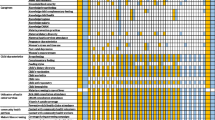Abstract
Programming platforms need to recognize the diversity of malnutrition epidemiology in India and choose appropriate implementation designs. With severe chronic malnutrition as the dominant epidemiologic entity, the net needs to be cast wide, focusing on: food security, health care, agriculture, water and sanitation, livelihoods and women’s empowerment. Community-based malnutrition treatment and prevention programs need to collaborate to complement treatment with socioeconomic and preventive interventions. Expansion of nutrition rehabilitation centers should be limited to areas/districts with high wasting. Pediatric services with nested nutrition services (including counseling) requires urgent strengthening. Continuum of Care is a weak link and requires strengthening to make both hospital and community-based models meaningful.
Similar content being viewed by others
References
International Institute for Population Sciences (IIPS) and Macro International. 2007. National Family Health Survey (NFHS-3), 2005-06;I:273.
Ashworth A, Chopra M, McCoy D, Sanders D, Jackson D, Karaolis N, et al. WHO guidelines for management of severe malnutrition in rural South African hospitals: effect on case fatality and the influence of operational factors. Lancet. 2004;363:1110–5.
Deen JL, Funk M, Guevara VC, Saloojee H, Doe JY, Palmer A, Weber MW. Implementation of WHO guidelines on management of severe malnutrition in hospitals in Africa. Bull World Health Org. 2003;81:237–43.
Bhutta ZA, Ahmed T, Black RE, Cousens S, Dewey K, Giugliani E, et al. Maternal and Child Undernutrition Study Group. What works? Interventions for maternal and child undernutrition and survival. Lancet. 2008;371:417–40.
Dibari F, Bahwere P, Huerga H, Irena AH, Owino V, Collins S, et al. Development of a cross-over randomized trial method to determine the acceptability and safety of novel ready-to-use therapeutic foods. Nutrition. 2013;29:107–12.
Community Based Management of Severe Acute Malnutrition. A Joint Statement by the World Health Organization, the World Food Programme, the United Nations System Standing Committee on Nutrition and the United Nations Children’s Fund. Available from: http://www.cmamforum.org/Pool/Resources/Community-basedmanagement-of-acute-malnutrition-Joint-Statement-WHOSCN-UNICEF-2007.pdf. Accessed June 29, 2014.
Community based management of Acute Malnutrition. Proposal for the Community-based Management of SAM in Madhya Pradesh. Available from: http://www.cmamforum.org/Pool/Resources/India-Madhya-Pradesh-management-of-acute-maln-OP-GUIDELINES-2012.pdf. Accessed June 29, 2014.
Prasad V, Sinha D, Sridhar S. Falling between two stools: operational inconsistencies between ICDS and NRHM in the management of severe malnutrition. Indian Pediatr. 2012;49:181–5.
Dasgupta R, Sinha D, Jain S, Prasad V. Screening for SAM in the community: Is MUAC a ‘simple tool’? Indian Pediatr. 2013;50:154–5.
Dasgupta R, Ahuja S, Yumnam V. Can Nutrition Rehabilitation Centers Address Severe Malnutrition in India? Indian Pediatr. 2014;51:95–9.
Bergeron G, Castleman T. Program responses to acute and chronic malnutrition: divergences and convergences. Adv Nutr. 2012;3:242–9.
Richard SA, Black RE, Checkley W. Revisiting the relationship of weight and height in early childhood. Adv Nutr. 2011;3:250–4.
Somassé YE, Bahwere P, Laokri S, Elmoussaoui N, Donnen P. Sustainability and scaling-up analysis of community-based management of acute malnutrition: lessons learned from Burkina Faso. Food Nutr Bull. 2013;34:338–48.
Collins S, Sadler K. Outpatient care for severely malnourished children in emergency relief programmes: A retrospective cohort study. Lancet. 2002;360:1824–30.
Taneja G, Dixit S, Khatri AK, Yesikar V, Raghunath D, Chourasiya S. A study to evaluate the effect of intervention measures on admitted children in selected nutrition rehabilitation centres of Indore and Ujjain divisions of the state of Madhya Pradesh (India). Indian J Community Med. 2012;37:107–15.
Alkire S, Santos ME. Acute Multidimensional Poverty: A New Index for Developing Countries. United Nations Development Programme Human Development Reports Research Paper 2010.
Park SE, Kim S, Ouma C, Loha M, Wierzba TF, Beck NS. Community management of acute malnutrition in the developing World. Pediatr Gastroenterol Hepatol Nutr. 2012;15:210–9.
Brown KH, Nyirandutiye DH, Jungjohann S. Management of children with acute malnutrition in resource-poor settings. Nat Rev Endocrinol. 2009;5:597–603.
Medecins Sans Frontiers. India: A step closer to effective treatment of severe acute malnutrition in Bihar. Available from: http://www.msf.org/article/india-step-closer-effective-treatment-severe-acute-malnutrition-bihar. Accessed April 26, 2014.
WHO, UNICEF. WHO child growth standards and the identification of severe acute malnutrition in infants and children A Joint Statement by the World Health Organization and the United Nations Children’s Fund, 2012.
Dalwai S, Choudhury P, Bavedkar SB, Dalal R, Kapil U, Dubey AP, et al. Consensus Statement of the Indian Academy of Pediatrics on integrated management of severe acute malnutrition. Indian Pediatr. 2013;50:399–404.
National Guidelines for the Management of Severely Malnourished Children in Bangladesh. Available from: http://www.unicef.org/bangladesh/SAM_Guideline.pdf. Accessed May 04, 2014.
DFID. Scaling up community based management of acute malnutrition; but doing it differently. Available from: www.coverage-monitoring.org. Accessed May 01, 2014.
Government of Maharashtra. Home based VCDC model. Available from: http://www.nutritionmissionmah.gov.in/Site/Common/homebasedVCDC.aspx. Accessed May 02, 2014.
FANTA-2. Title II Technical Reference Materials. TRM-01: Preventing Malnutrition in Children under 2 Approach (PM2A): A Food-assisted Approach. Revised November 2010; Washington, DC: Food and Nutrition Technical Assistance II Project (FANTA-2).
Dasgupta R, Yumnam V, Ahuja S, Roy S. The Conundrum of continuum of care: Experiences from the NRC model, Madhya Pradesh. Oral presentation at the South Asia Conference on Policies and Practices to Improve Nutrition Security, SAC-OP-07-05; 2014 July 30–31, New Delhi, India. Available from: http://www.nutritioncoalition.in/thematic-oral-presentations. Accessed June 16, 2014.
Chaand I, Dasgupta R. Mapping transitions in food insecurity in ‘pure’ tribal villages: village studies in Latehar, Jharkhand. Poster presentation at the South Asia Conference on Policies and Practices to Improve Nutrition Security, SAC-PP-01-04; 2014 July 30–31, New Delhi, India. Available from: http://www.nutritioncoalition.in/thematic-poster-presentations. Accessed June 16, 2014.
Garg S, Mishra JP. Caregiver Managed Nutrition and Day Care Centres Panchayat-Led Fulwari Scheme of Chhattisgarh State. Oral presentation at the South Asia Conference on Policies and Practices to Improve Nutrition Security, SAC-OP-07-02; 2014 July 30-31, New Delhi, India. Available from: http://www.nutritioncoalition.in/thematic-oral-presentations. Accessed June 16, 2014.
Action Against Malnutrition: A multi-strategy intervention in six blocks of three states. Available from: http://www.phrnindia.org/our_work/actionAgainstMalnutrition.html. Accessed June 16, 2014
World Bank. Improving Nutrition Through Multisectoral Approaches. 2013. Available from: file:///C:/Users/a/Downloads/751020WP0Impro00Box374299B00PUBLIC0.pdf. Accessed May 12, 2014.
Author information
Authors and Affiliations
Corresponding author
Rights and permissions
About this article
Cite this article
Dasgupta, R., Sinha, D. & Yumnam, V. Programmatic response to malnutrition in India: Room for more than one elephant?. Indian Pediatr 51, 863–868 (2014). https://doi.org/10.1007/s13312-014-0518-5
Published:
Issue Date:
DOI: https://doi.org/10.1007/s13312-014-0518-5




